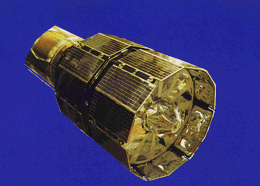ESRO 2B
 | |
| Mission type | Astrophysics |
|---|---|
| Operator | ESRO |
| COSPAR ID | 1968-041A[1] |
| SATCAT no. | 03233 |
| Spacecraft properties | |
| Launch mass | 89.8 kilograms (198 lb) |
| Start of mission | |
| Launch date | 17 May 1968, 02:06:00 UTC[2][1] |
| Rocket | Scout B |
| Launch site | Vandenberg SLC-5 |
| End of mission | |
| Decay date | 8 May 1971, shortly after 03:00 UT |
| Orbital parameters | |
| Reference system | Geocentric |
| Regime | Low Earth |
| Perigee altitude | 326 kilometres (203 mi)[2] |
| Apogee altitude | 1,086 kilometres (675 mi)[2] |
| Inclination | 97.2 degrees[2] |
| Period | 98.9 minutes[2] |
| Epoch | 16 May 1968, 22:09:00 UTC[3] |
ESRO-2B or Iris (International Radiation Investigation Satellite; sometimes Iris 2[4]) or sometimes ESRO II (or ESRO 2), was a European astrophysical spin-stabilised research satellite which was launched in 1968. Operated by the European Space Research Organisation, ESRO 2B made astronomical surveys primarily in x-ray and solar particles detectors.[5]
Spacecraft
ESRO-2B was an 89 kg (196 lb) cylindrical spacecraft with a length of 85 cm and a diameter of 76 cm. On 10 December 1968 (approx 195 days since mission start) the on-board tape recorder suffered a mechanical failure. This effectively ended the two X-ray experiments as they did not provide any significant data return from then on. Other experiments could still be operated through ground radio links.
ESRO-2B was launched on a Scout B rocket into a highly elliptical near-polar orbit on 17 May 1968. Its predecessor satellite, ESRO-2A (sometimes Iris 1) failed to reach orbit on 29 May 1967,[6] launching on a Scout B rocket from Vandenberg AFB SLC-5. The cause of failure was malfunction of the third stage of the rocket, preventing the satellite from reaching orbit. ESRO-2A was similar to ESRO-2B except it weighed a little less (74 kg).[4]
Spin-stabilised, ESRO-2B had a spin rate of approximately 40 rpm and re-entered Earth's atmosphere on 8 May 1971 after completing 16,282 orbits.[4]
Instruments
Seven instruments were carried aboard EROS 2B[2] designed to detect high energy cosmic rays, determine the total flux of solar X-rays and to measure Van Allen belt protons and cosmic ray protons.[5] While designed for solar observations ESRO-2B is credited with the detection of X-rays from non-solar sources.[2] The instruments were:
- Monitor of Energetic Particle Flux
- Solar and Van Allen Belt Protons
- Solar and Galactic Alpha Particles and Protons
- Primary Cosmic Ray Electrons
- Hard Solar X-rays
- Soft Solar X-rays
- Flux and Energy Spectra of Solar and Galactic Cosmic Ray Particles
References
- ^ a b "NASA – NSSDCA – Spacecraft – Details".
- ^ a b c d e f g "ESRO 2B". NASA. Retrieved 6 March 2013.
- ^ "NASA – NSSDCA – Spacecraft – Trajectory Details". nssdc.gsfc.nasa.gov. Retrieved 1 May 2018.
- ^ a b c "ESRO 2A, 2B (Iris 1, 2)". Gunters Space Page. Retrieved 6 March 2013.
- ^ a b "ESRO 2B: May – December 1968". University of Indiana. Retrieved 6 March 2013.
- ^ "NASA – NSSDCA – Spacecraft – Details".
